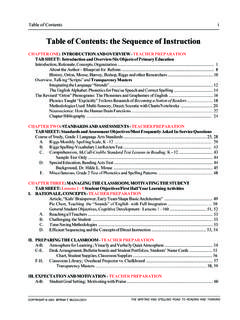Transcription of What is May Day, and what exactly is a May Pole?
1 what is may day , and what exactly is a May Pole? Well, you may regret asking the question, but we may as well get this question out of the way now. The May Pole represents an erect male penis. It s true, May Poles are phallic symbols. They were used in British fertility rites to usher in spring and ensure fecundity in crops and livestock. Villagers would go out into the forest, cut down an appropriately sized tree, and decorate it in the town square with ribbons and flowers. may day is not an overly prominent holiday in America. Yet, it does have a long and notable history as one of the world s principal festivals. The origin of the may day as a day for celebration dates back thousands of years. And like many ancient festivals it too has a Pagan connection. In the photo here, young women dance around this fertility pole For the Druids of the British Isles, May 1 was the second most important holiday of the year when the festival of Beltane held. It was thought that the day divides the year in half.
2 The other half was to be ended with Samhain (Halloween) on November 1. In those days the may day custom was the setting of new fire. It was one of those ancient New Year rites performed throughout the world. And the fire itself was thought to lend life to the burgeoning springtime sun. Cattle were driven through the fire to purify them. Men, with their sweethearts, passed through the smoke for good luck. The word Beltane is derived from the Irish Gaelic Bealtaine or the Scottish Gaelic Bealtuinn , meaning Bel-fire , the fire of the Celtic god of light (Bel, Beli or Belinus). He, in turn, may be traced to the Middle Eastern god Ba al. Bonfires (bone fires from human sacrifice) were lit, and leaping the fire was a custom thought to encourage the crops to grow as high as the leaper could leap the fire. These fires, also called balefires or need-fires were thought to have healing properties, thus we have the tradition of sky-clad (naked) witches leaping the fire to ensure protection.
3 After one s own birthday, the two major Satanic holidays are Walpurgisnacht [May 1st or may day ] and Halloween (or All Hallow s Eve). The Satanic Bible, page 96 St. Walpurgis or Walpurga, or Walburga, depending upon the time and area in which one is referring to her was born in Sussex about the end of the 7th or the beginning of the 8th century. She was educated at Winburn, Dorset, where after taking the veil, she remained for twenty-seven years. She then, at the insistence of her uncle, St. Boniface, and her brother, St. Wilibald, set out along with some other nuns to found religious houses in Germany. Her first settlement was at Bischofsheim in the diocese of Mainz, and two years later (754 ) she became abbess of the Benedictine nunnery at Heidenheim, within her brother Wilibald s diocese of Eichatadt in Bavaria, where another brother, Winebald, had at the same time also been made head of a monastery. On the death of Winebald in 760 she succeeded him in his charge, retaining the superintendence of both houses until her death on February 25, 779.
4 Her relics were translated to Eichstad; where she was laid in a hollow rock, from which exuded a kind of bituminous oil, afterwards known as Walpurgis oil, regarded as having miraculous efficacy against disease. The cave became a place of pilgrimage, and a great church was built over the spot. She is commemorated at various times, but principally on May 1st, her day taking the place of an earlier Pagan festival. Amazingly enough, all of this rigmarole was found necessary simply to condone the continuance of the most important Pagan festival of the year the grand climax of the spring equinox! (Antone La Vey, ibid. pp. 96-98) Long before the life of St. Walpurgis, May 1 coincided with a pre-existing pagan festival, which, in Germany, included rites to protect one against witchcraft. This led to a hybrid legend developing in which witches were said to meet with the Devil on the eve of May 1. The night of April 30th became known as Walpurgisnacht, (German for Walpurgis night).
5 Here we see the true intent of Catholicism s adoption of the Pagan holydays and their disguising them as Christian holydays such as New Years, Valentine s Day, Easter, Halloween, Thanksgiving and Christmas. In this case it was done through a practicing satanic family operating within Roman Catholicism. They became instrumental in spreading this false religion across Northern Europe. In the twentieth century many neo-pagans began reconstructing the old traditions and celebrating may day again as a pagan religious festival. By the Middle Ages every English village had its Maypole. The bringing in of the Maypole from the woods was a great occasion and was accompanied by much rejoicing and merrymaking. The Maypoles were of all sizes. And one village would vie with another to show who could produce the tallest Maypole [a form of penis envy if I ve ever heard one]. Maypoles were usually set up for the day in small towns, but in London and the larger towns they were erected permanently.
6 The changes brought about by the Reformation included attempts to do away with practices that were obviously of pagan origin. Although they succeeded in doing this, Maypole with most of the other traditions, survived. may day observance was discouraged by the Puritans. Though, it was revived when the Puritans lost power in England, it didn t have the same robust force, so the day has never been celebrated with as much enthusiasm in the United States as in Great Britain. But the tradition of celebrating may day by dancing and singing around a maypole, tied with colorful streamers or ribbons, survived as a part of the English tradition. Gradually, it came to be regarded more as a day of joy and merriment for children, who celebrated the day by moving back and forth around the pole with the streamers, choosing a May queen, and hanging of May baskets on the doorknobs of folks (all the leftovers of the old European traditions), rather than a day of observing the ancient fertility rights, very similar to the adoption of the fertility rite of Easter, another children s holiday.
7 Trees have always been part of pagan celebrations. Trees have always been the symbol of the great vitality and fertility of nature and were often used at the spring festivals of antiquity. Anthropologist E. O. James finds a strong relationship between the ancient tree-related traditions of the British and the Romans. According to James description, as a part of the may day celebration, the youths in old Europe cut down a tree, lopped off the branches leaving a few at the top perhaps unknowingly to simulate the glans penis. They then wrapped it round with violets and at sunrise, they would take it back to their villages by blowing horns and flutes. May-pole most clearly remains today. It is the phallus, the male principle of fertilization. Female principles are represented by baskets and wreaths used in the dances around the pole. In past times, the dances would give young couples license to go into the green together. In some regions, a merlin, or renegade friar, would preside over the mock marriages.
8 Even today, unwed couples consummate the mock marriages performed around the May-pole. Merry-begats, as the resultant offspring were called in England, were usually not acknowledged by their fathers. These babies were said to have been fathered by god. Beltane, or may day , is one of the Great Sabbats of the Wiccan calendar. Of the four Great Sabbats, Beltane is one of the most important, second only to Samhain (Halloween). Beltane is chronologically opposite of Samhain, splitting the year evenly. Most Wiccans celebrate the holiday on May 1st, however by Celtic reckoning; the actual celebration begins on sundown of April 30, because the Celts and other pagans always figured their days from sundown to sundown. Ye cannot drink the cup of the YHVH, and the cup of devils: ye cannot be partakers of the YHVH s table, and of the table of devils, I Corinthians 10:21. Choose you this day whom ye will as for me and my house, we will serve YHVH, Joshua 24:15.








